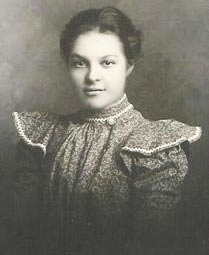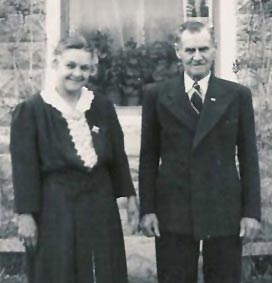
Courtesy Kay Sanders Collection
The information below has been compiled from a variety of sources. If the reader has access to information that can be documented and that will correct or add to this woman’s biographical information, please contact the Nevada Women’s History Project.
At A Glance:
Born: October 2, 1881 in Bodie, California
Died: February 2, 1973 in Lovelock, Nevada
Maiden Name: Martha Letcher Hawkins
Race/Nationality/Ethnic Background: Caucasian, both parents born in Cornwall, England
Married: Peter Johansen Gottschalk, 1904, in Reno, Nevada
Children: Arthur, Elma, George, Alice, Earl, and Robert
Primary City and County of Residence and Work:
Reno, Washoe County, Nevada from 1882 to 1904; Lovelock, Pershing County, Nevada from 1904 until her death in 1973
Major Fields of Work: Nurses aide at Washoe County Hospital, Wife, Mother, Methodist Church volunteer
Other Role Identities: Student at Bishop Whitaker School for Girls, Care giver for elderly in Pershing County, Waitress, Ladies Aide Society member, Orphan
Born in Bodie, California, October 2, 1881, to a Cornish miner and his wife, Martha Letcher Gottschalk began her life’s journey in a lawless, gold and silver mining camp in the Wild West. Daily shootings, frequent mine accidents, and recurring epidemics were the norm in western mining boom towns in those early days. Bodie was no exception. It was notorious for being the most wild and dangerous of all the camps. Located in the eastern Sierra Nevada Mountain area at an elevation of 8,374 feet, the town was in its “golden days” in 1881.
Six months after Martha’s birth, her mother, Martha Adams Letcher, died from an epidemic disease, possibly typhoid pneumonia. It was said that she had helped nurse sick miners and their families until she, too, succumbed to the deadly illness. The gravesite of her mother exists today in the Miner’s Section of the Bodie Cemetery. Her father was helped by a kindly Irish boardinghouse owner, Annie Sullivan, who cared for his baby daughter until other arrangements could be made.
Eventually she was placed with a Cornish immigrant family in Reno, Nevada as John had to work as a miner to support his daughter. Bodie was no place for a single parent trying to work the long shifts demanded of the miners. The family who took her was headed by Ellen Downs Hawkins who was a widow and had immigrated to the United States in 1875 from Cornwall to search for her son Thomas Hawkins. Thomas owned the Granger House on the corner of Virginia and Second Streets in Reno.
Martha recalled her father as “a large man who would scoop her up in his arms and hold her aloft” whenever he came to visit. She was given photos of her father and a portrait of her mother when she was an adult. From his photos John Letcher appears to be of large stature with a handle-bar moustache, dark eyes and hair, and a kindly, but serious look in his eyes. The last verifiable record the family has of him is a receipt for $40 from Wells, Fargo & Co. Express from Jackson, California in 1886 whose recipient was Mrs. E. Hawkins. Sadly, John did not live to see his daughter grow to womanhood. Differing accounts of his disappearance and death were told to Martha by members of the Hawkins family. None of them were substantiated, however, and her descendants have never been able to verify the circumstances of his demise – an unsolved mystery. His watch and gun were given to Martha years later by a member of the Hawkins family in Reno.
This left Martha orphaned at a young age. Occasionally, when reflecting on her childhood, she would confide that this was one of her most deeply felt losses, “to have never known her mother and having only vague memories about her father.” It was unusually difficult for her since she had no known relatives, even in Cornwall. In the Hawkins family she was especially close to Ellen, a native of St. Ives, Cornwall, who died in 1897 in Reno at the age of 72.
Martha was baptized at the Trinity Episcopal Church in Reno on February 28, 1892 . Her name on the baptismal record was Martha Letcher Hawkins but no record has been found verifying that she was officially adopted by the Hawkins. She attended Bishop Whitaker’s School for Girls in northwest Reno and is listed in their 1892-1893 annual catalogue as a member of the Preparatory Class. The school closed due to insufficient funds before she was able to graduate. It was located in the northwest section of Reno on top of a small hill. Martha recalled the fun she had “rolling hoops down the hill at the school”, which is now the site of Ralston Park. Her home with the Hawkins family was near the current site of St. Mary’s Hospital on Chestnut Street . Since William Lampson, the husband of one of the Hawkins’ daughters, was a part-time miner, she spent some time in her teen years at Rye Patch and Fitting in Buena Vista Valley which were located at that time in Humboldt County.
As a girl she worked as a waitress in the Train Station Café in Reno, according to one of her grandsons, and one summer she worked at a resort at Independence Lake near Graeagle, California. According to her remembrances, it was at this resort that she was noticed by the President of Stanford University who encouraged her to pursue her education. He was impressed by her intelligence and demeanor. This was not to be her future, however.

Photo Credit:
Courtesy Kay Sanders Collection
Martha had a beautiful soprano voice. Most of her children inherited this natural talent. Her second son George auditioned at the San Francisco Opera but chose a different career. Her children performed in local musicals in Lovelock and sang in school choirs. They were often asked to sing or play the piano, and other musical instruments, at various local functions including weddings, funerals, school programs, and special community events.
Life in early 20th century Lovelock involved much hard work. Water had to be hand pumped from a well in the back yard. Heat was provided by a central wood and coal burning stove in the living room. Money was scarce and everyone had to pitch in to help provide for the large family. Local Native Americans assisted with the weekly washing chores. Paiute fishermen from Pyramid Lake would bring fresh caught trout from the Lake to Lovelock Valley in wagons loaded with ice and straw to keep the fish cold. Everyone had their own chickens, gardens and fruit trees to augment their diets. The sons worked at ranches during their summer vacations.
Martha would faithfully prepare her children for Sunday school and church and was a loyal member of the Lovelock Methodist Episcopal Church. Her activities with the Ladies Aid Society included meeting trains carrying WWI troops to the East and handing out cookies, drinks, and snacks to the soldiers. She assisted with fund-raising events and church celebrations. Her husband Peter and brother-in-law Christian Gottschalk ran a saloon in Lovelock until a fire destroyed the business in the early 1900s. With a large family to support Peter had to change his occupation since there was no insurance in those days to recover the loss. He started a plumbing business and did occasional prospecting in the Ragged Top Mountain area. Peter broke his hip when he was in his 80s and Martha helped him during his convalescence. He returned to full health after her devoted care.
She reached out to help the poor and lonely widows in Lovelock who were ill and not able to shop anymore by making sure they did not go hungry. Many were the trips the author remembers of accompanying Grandma Martha on her way to downtown Lovelock, picking up lists from the homebound, and delivering food and other necessities on the way return trip to frail, elderly people. She was unfailingly loyal to and thoughtful of her neighbors. Her generosity and compassion were boundless. Since she did not learn to drive and never owned a car, she walked everywhere. This probably helped her to remain healthy as she continued this exercise until her death.
Martha’s sense of humor was wonderful. She had a mental stock of sayings for every occasion – mostly original and always appropriate. “Oh, it’s this life and the next,” is one the author remembers. She loved to laugh and could find humor in extremely trying situations. By nature cheerful, she looked at the bright side. Her glass was always half full, not half empty.
During WWII four of her six children served in the military: her sons George in the Navy, Earl in the Seabees, Robert in the Air Force, and daughter Elma in the Women’s Army Corps. All of them saw active duty in war zones. Her eldest son Arthur was the first Postmaster of the U.S. Post Office in Lovelock, was elected as short-term Commissioner, and also served two terms as Pershing County Recorder/Auditor. Her daughter Alice taught school during the war at the original Anderson School in Reno while her husband Bob was serving in the Navy. She also taught in California for many years until her retirement. George settled in Carson City . He was a businessman and was elected to the position of Carson City Supervisor. Earl, also a businessman, served on the Land Bank Board of Directors. Elma retired after 30 years as secretary to the Nevada State Attorney General. Robert became a rancher in Lower Valley, Lovelock and served for 16 years on the Pershing County Water Conservation District Board of Directors.
Peter passed away in 1951 leaving Martha widowed for 22 years. She had never been east of Salt Lake City, Utah until 1959 when daughter Alice and son-in-law Bob Downer took her on a road trip to Washington, D.C. She was so excited to see the different states, the changing landscapes, and tour our nation’s capitol.
Martha’s descendants include 11 grandchildren, 22 great-grandchildren, and 30 great-great grandchildren. Her life story is a compelling example of life in the frontier west. Born in a mining boom town, orphaned while a young child, raised by Cornish immigrants in Reno, most of her life was spent in the Nevada desert town of Lovelock. There she bore and raised her six children and resided after her husband’s death. Martha epitomized the courage, adaptability, faith, generosity, and optimism of women in the West. Her heritage lives on today in her many descendants.
Researched and written by Kay Sanders (Martha’s oldest granddaughter) October 2006
Sources of Information:
- Personal conversations with Martha Letcher Gottschalk by Kay Sanders.
- Bragg, Allen C., Humboldt County 1905, Saloons, p . 90. Published by the North Central Nevada Historical Society, Winnemucca, Nevada , 1976. (Note: The spelling of Gottschalk was in error. Change Godchaux Brothers to Gottschalk Brothers.)
- Daily Reveille , Austin , Nevada , April 16, 1878.
- Territorial Enterprise , Virginia City , Nevada , April 19, 1878.
- Trinity Episcopal Church, Reno, Nevada, Baptismal Records , pp. 70-71, No. 357, February 18, 1892.
- Whitaker Hall, A School for Girls, Annual Catalogue, 1892-1893 , p. 22. Reno , Nevada.
